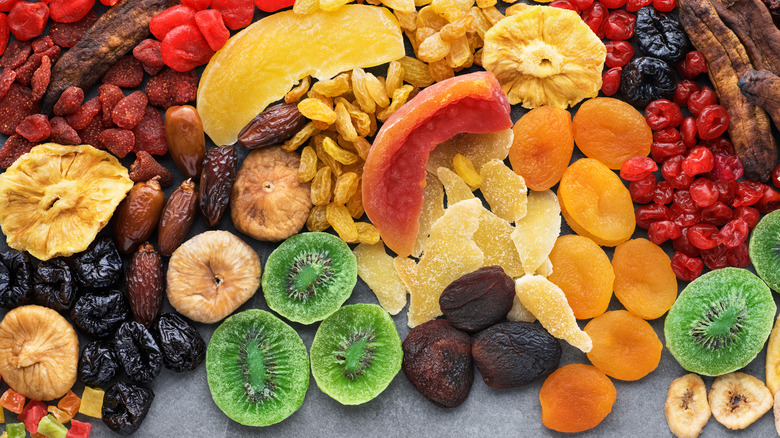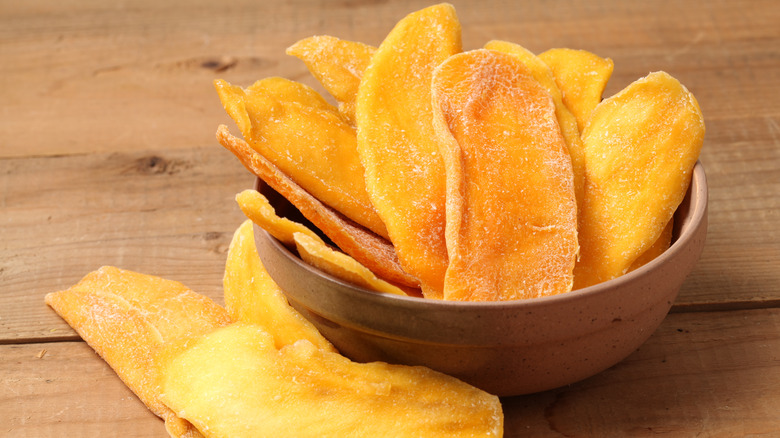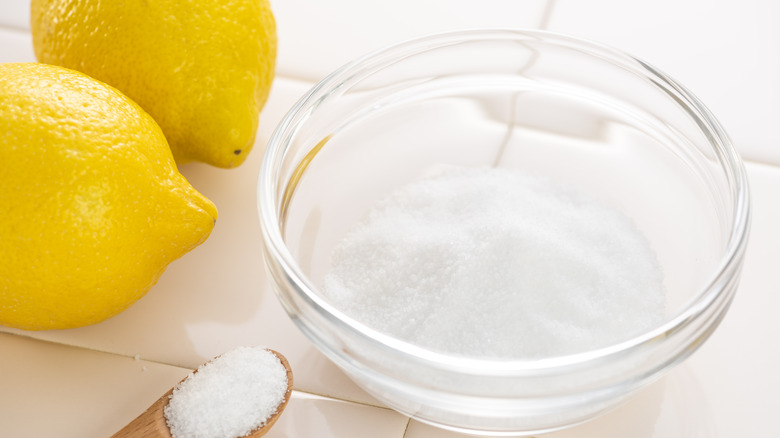How To Turn Your Forgotten Dried Fruit Into Nostalgic Candy
Maybe you overstocked on dried fruit from Costco, ordered the incorrect package in your online grocery haul, or just got a little carried away at the supermarket. An overabundance of a certain item may seem like a snacking burden, but with the addition of two ingredients, you can quickly and easily transform any dried fruit into sour candy — no molten sugar or special thermometer required. All you need is some citric acid and regular old white sugar.
Citric acid is very sour, so you definitely need to cut it with sugar for this hack to work. A ratio of two parts sugar to one part citric acid is a good place to start. Simply stir the granules together, pulse the mixture in a food processor, or grind it with a mortar and pestle for a finer texture, if preferred. Coat your dried fruit in this homemade sour powder and enjoy!
If you do not already have citric acid on hand to give this homemade sour candy a try, you can buy it at some supermarkets near the canning supplies, natural food stores, restaurant supply stores, home brewing shops, and online. It is also sometimes labeled as "sour salt."
Tips for making dried fruit sour candy
Any kind of dried fruit will work for this application, but those that are already sweetened will taste more like candy. If your dried fruit is unsweetened, you may want to increase the ratio of sugar to citric acid. For dried fruits with a soft inside like pineapples, pears, kiwis, prunes, and apricots, you can slice the fruit in half and press the sticky side into your sour mixture. For those with less moisture like mangoes, apples, or papayas, or small fruits like cherries or cranberries, dip them in simple syrup first, so the citric acid blend will stick.
You may be tempted to roll the sour powder on in a thick layer, but citric acid has an intense flavor, so it is best to exercise some restraint. To make mixed fruit candies, blend any combination of dried fruits into a paste in the food processor along with some sugar and citric acid to taste, cook for a few minutes in a saucepan to thicken the mix, roll it into balls once cooled, and then toss everything in your sour mixture if you want a powdery coating.
Add some intrigue to your citric acid mixture with the addition of some fresh citrus zest, a flavored water packet, salt, or chili powder. Keep a little extra of the mix on hand for dusting fresh fruit, seasoning vegetables like jicama and cucumber, or for whenever the dried fruit sour candy craving strikes.
What is citric acid?
While citric acid may sound more suited for a science experiment than a sweet treat, it is common in many foods and beverages. Citric acid occurs naturally in sour fruits like pineapple, cranberries, raspberries, tomatoes, and strawberries — and in higher concentrations in all citrus fruits. The citric acid you see listed on ingredient labels can either be derived from lemons or a manufactured version that comes from a type of mold. The acid is used as a flavor enhancer and preservative, but it is also used in medicines and cleaning supplies. Both versions are commonly added to canned foods, jams, juices, candy, and even soft drinks. Regardless of origin, citric acid is considered safe to eat by the Food and Drug Administration – though there are some anecdotal reports of adverse reactions to the synthetic version.
Citric acid is shelf stable as long as you keep it away from moisture, so store it tightly sealed in a cool, dry, dark, place. Think of it as a sour flavor enhancer that you can use to introduce tang without adding any more liquid — like for extra-sour sourdough bread, lemon curd, citrus-based cocktails, seasoned roasted nuts, or fruit sorbets. It can also be used to make fresh cheeses that require acidified milk like mozzarella and ricotta, in marinades or dry rubs to tenderize meat, to prevent cut fruit from browning, and to maintain the flavor, color, and safety of homemade canned foods.



